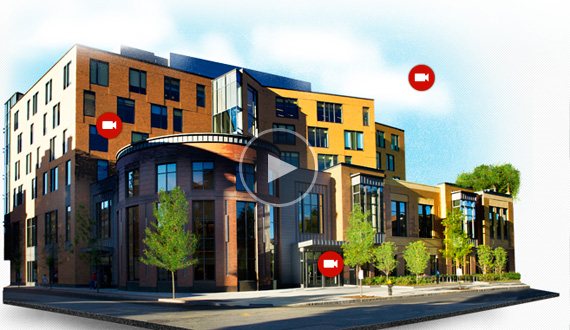Category: Fall 2012 Features
University unveils $1 billion, five-year campaign
The ambitious Campaign for Boston University will go a long way to defining BU’s future. It’ll also have a positive impact on today’s students.
By Rich Barlow. Video by Alan Wong
Why, after 173 years, is Boston University mounting its first comprehensive fundraising campaign? And why the daunting target of $1 billion, a figure that no school has ever aimed for in a first campaign?
Campaign Chair Kenneth Feld (SMG’70) says he hears the answer every time he travels. “BU is now at a stage where it is breaking through,” says BU Trustee Feld, whose family business—Feld Entertainment—owns Ringling Bros. and Barnum & Bailey® and Disney On Ice, among other properties. “The level of fame that has come to BU internationally is extraordinary. This is the absolute right time.”
President Robert A. Brown offers a similar response: the BU community is ready. “The Board of Trustees voted in April 2010 to authorize us to explore the feasibility of a billion-dollar campaign,” says Brown. “It has become clear that our alumni and other friends are prepared to support this ambitious effort, so we are moving forward. Nothing will be more important for the future of the University than our success.”
Nurturing Strengths
And while the Campaign for Boston University had its official launch in September 2012 at Agganis Arena, where the Boston Pops Orchestra and other performers entertained alumni, students, parents, and guests, the groundwork was put in place shortly after Brown took office seven years ago, when he set administrators to work on a strategic plan that would describe their vision for the University. The document that emerged, Choosing To Be Great, took stock of the University’s strengths—renowned faculty, an increasingly gifted student body, healthy finances, and its international students and programs. It also identified priorities that would enhance and nurture those strengths, with the understanding that realizing those priorities would necessitate changes in the University’s funding strategy. At the same time, a disciplined budgeting process—long a BU strength—would be critical. “A vision without a budget,” Brown likes to say, “is a hallucination.”

The Campaign for Boston University kicked off in grand style in fall 2012. Photo by Kristyn Ulanday
Because BU does not have the hefty endowment that substantially supports the operating budgets of some peer institutions, the University can count on endowment income for only approximately 4 percent of its operating budget, and on fundraising income for another 5 percent. (These figures are half of what many other private universities of comparable quality, scale, and scope depend on.) And although “this distinctive business model has helped build a great university,” according to Scott Nichols, senior vice president for development and alumni relations, “it’s high time for philanthropy to play a larger role.”
For example, Boston University currently gets 53 percent of the money it needs for buildings through borrowing, with just 6 percent coming from gifts and grants. The President and Trustees hope to substantially shift this balance, says Nichols, so that in the future, 50 percent can come from gifts and just 20 percent from borrowing.
Nichols says that without a major fundraising effort, an even greater burden will have to be placed on tuition, which is something that neither Brown nor the Trustees are willing to accept. This commitment is among the many reasons BU Trustees and Overseers have personally stepped up and pledged $130 million collectively to kick-start a campaign with a $1 billion goal.
While the campaign officially opened this fall, an unofficial “quiet” period began about two years ago, and it has yielded some impressive results. They include $25 million from Trustee Rajen Kilachand (GSM’74), the largest gift in BU history, to endow the Arvind and Chandan Nandlal Kilachand Honors College, and $15 million from Trustee Bahaa Hariri (SMG’90), for the Rafik B. Hariri Institute for Computing and Computational Science & Engineering.
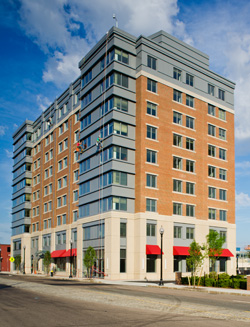
The new School of Medicine student residence. Photo by Cydney Scott
Campaign for Boston University gifts have also made possible the new School of Medicine student residence, the expansion and renovation of the School of Law, and the New Balance athletic field. They fund important professorships, such as the Peter Paul Professorships for junior faculty, given by Trustee Peter Paul (GSM’71), and a $1 million gift for the Reidy Family Career Development Professorship at the College of Engineering from Trustee Richard Reidy (SMG’82). For the past two years and through to the 2017 campaign finale, Trustee Richard Cohen (CGS’67, SMG’69) has pledged $300,000 a year to help send 15 undergraduate students to BU.
One distinctive feature of the campaign is the Century Challenge, an innovative program aimed at raising support for undergraduate scholarships. The proposition works like this: if a donor contributes $100,000 or more to establish an endowed undergraduate scholarship fund, the University will use funds from its existing financial aid budget to match the payout from that fund every year for 100 years (up to a maximum of $100 million). In effect, this will double the impact of the donor’s named gift.
Where Will the $1 Billion Go?

Photo by Cydney Scott
The campaign’s overall objectives are to allocate $150 million for support for students to ensure that BU remains accessible to highly qualified candidates, and $200 million for support for faculty to help recruit and retain outstanding scholars and teachers. The University has vowed to continue its program of gradually raising faculty salaries to competitive levels; a related goal is to increase the number of endowed professorships. The campaign’s goals also include $250 million to support research; $150 million to maintain and improve facilities; $150 million for special programs such as career services, libraries, and athletics; and $100 million for unrestricted and current-use gifts.
Parents, in particular, have a tradition of making immediate-impact gifts, says Jeanne Knox, chairman of the Parents Leadership Council and mother of Merrill (COM’06) and Bobby (CGS’08, SAR’10, SPH’12). The campaign, she adds, gives parents the chance to make a gift that will help current students—and create a legacy that will endure long after their own children have graduated.
“My children have benefited greatly from their BU experiences, which is one of the many reasons my husband, Bob, and I are so dedicated to the future success of the institution,” says Knox. “By participating in the campaign, and particularly in the Century Challenge, parents have the opportunity to improve their child’s college experience while also providing for future generations of BU students.”
And, according to Nichols, the broader choices that must be made during the campaign—which schools get how much money, which buildings get built, which professorships get funded, which programs get expanded, and so on—will go a long way toward defining the future of the University.
Which is why, he says, everyone needs to play their part. “Every contribution will be important.”
A version of this article originally appeared in BU Today. Additional reporting contributed by Andrew Thurston.
Reporting the Olympics
The seven Terriers competing at the 2012 Olympics weren’t BU’s only representatives in London this summer. Fourteen communication students reported from the city during a one-off study abroad program.
By Ashley Lisenby (COM’13)
Author photo courtesy of Ashley Lisenby
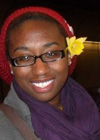
Ashley Lisenby
I am convinced reporting in London during the 2012 Olympics was a dream. Never in my wildest imagination did I think that I would be one of 14 Boston University graduate and undergraduate students interning for New England news outlets during the Summer Olympics.
The first three weeks of the program were devoted to a class on the history and politics of the Olympics; the last three weeks, to reporting for our news outlets. I had the privilege of working for Boston’s National Public Radio station, WBUR; other students were assigned to outlets such as Boston.com and WBZ.
Over the course of the trip, I visited the Olympic Park; met International Olympic Committee members and Getty Images photographers; attended an Olympic women’s soccer game; toured the BBC media center and the International Broadcast Center; and interviewed a British amateur boxer, a British Olympic basketball player, and an American Olympic rower.
My meeting at WBUR before the internship began felt like the moment in the dream when you are falling, and excitement and fear are fighting in your stomach. The station’s executive producer and web producer met with me and my internship partner to discuss their expectations of us. I remember thinking afterward, I hope I measure up.
Crossing the Pond

Raising cell phones in Trafalgar Square to record the end of the countdown to the start of the games. Photo by Megan Happ © Boston University News Service
My first assignment for the trip was to work on the Boston University Olympics website. Between journalism professor Michelle Johnson’s web expertise and my interest in web design and coding, we fashioned a site to showcase the work of BU’s Olympics reporters.
Aside from getting the website ready for the games, I was most excited about covering female athletes and women’s sporting events, especially boxing, which had its Olympic debut in 2012. My first pre-Olympic piece was on British amateur boxer Marianne Marston, the “Golden Girl.”
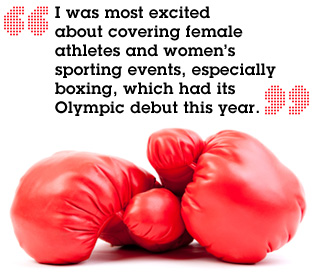
I arrived early at the gym where Marston teaches women’s-only boxing classes and waited until she arrived. Marston had no idea a reporter was coming that day.
She was direct and soft-spoken, but not timid. I recorded ambient sound of Marston training her student—the sound of gloves smacking hollow plastic pumped through my speakers.
After the class ended, I asked a few more questions, and I left the gym feeling accomplished and less intimidated. I thought: I can do this.
Then my first official assignment for WBUR’s Only A Game arrived. My internship partner and I had to gather the voices and sounds of London. We made mental lists of iconic London landmarks such as Big Ben, the Houses of Parliament, Westminster Abbey, and the London Eye in order to capture the sounds of a city on the brink of Olympic frenzy and the thoughts of people caught in the whirlwind.
On the day of the Olympic Opening Ceremonies, at 8:12 a.m., people gathered at famous landmarks to ring bells to welcome the start of the games. From the toll of Big Ben to bike bells on the sidewalk, London was alive with ringing for three minutes. I was capturing a fraction of the festive welcome from Leicester Square, not far from famous Piccadilly Circus, where a group had gathered around the Swiss Glockenspiel musical attraction.
A few days after we submitted the voices and sounds of London, our work was heard on NPR’s Only A Game.
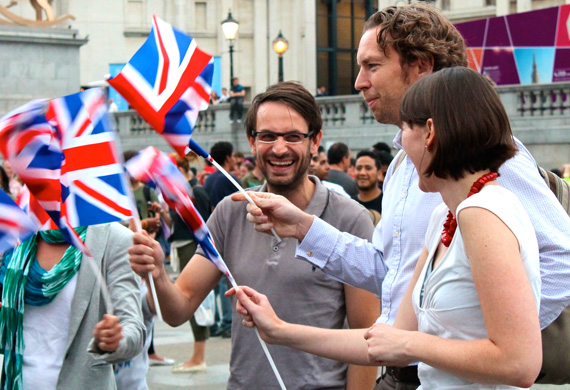
Waving flags in anticipation of the opening ceremony. Photo by Amy Gorel © Boston University News Service
One of my favorite stories involved gathering reactions to “London Boosted,” an Olympic-themed installation by Czech artist David Cerny. Accompanied by grunts and groans, a vintage double-decker bus practiced push-ups with giant mechanical arms. Crowds of passersby stopped outside the Czech Hospitality House in North London to marvel or scoff at the athletic bus.
Another piece was about the much-anticipated gold medal women’s soccer match between the United States and Japan. My internship partner and I were on a mission to talk to fans from both teams. We were surrounded by flag-bearing, cape-clad, face-painted fans eager to tell two reporters how they got to the Olympics and who they hoped would win. To our surprise, disappointed Japanese fans were just as eager to talk to us after the game ended with an American victory.
Finally, perhaps one of the most memorable moments I had in London was interviewing U.S. Olympic rower Will Miller and his parents outside the Olympic U.S. Hospitality House. He and his parents spent an hour or so talking with two Boston.com interns and me about Massachusetts, rowing, and the Olympics. It was an honor to speak with the athlete, but his mother, in my opinion, delivered the most memorable and poignant words of the interview.
As a parent, said Sally Miller, “You’ve been there all along. You’ve watched them from when they were little and you’ve encouraged them as they’ve grown. And now you give them wings and let them go and hope they are just as happy with all of this as you are.”
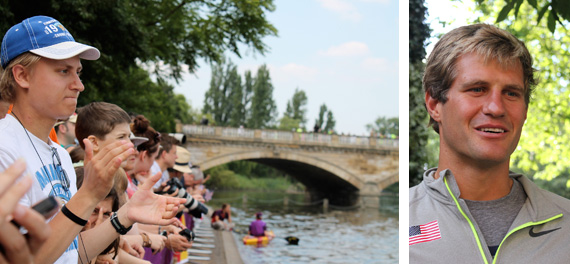
Crowds (left) at a rowing event. Photo by Amy Gorel © Boston University News Service. Rower Will Miller (right), Duxbury, Mass., native, met with BU interns to talk about his Olympics experience. Photo by Megan Happ © Boston University News Service
Lessons Learned
In the moments when no one was responding to my emails or phone calls and I wanted to give up, I realized that if I gave up on myself, it was unlikely that I was going to convince anyone else to take me seriously. I learned how to be persistent. I also learned that, while it is an accomplishment to get to a source first or have an exclusive interview, it is nearly impossible for one reporter to do everything on his or her own. Collaboration with other reporters in other mediums helps make a project stronger and well rounded.
My mother and grandmother tell me that from the time I started to write, I was writing sentences with misspelled words and backwards Rs on pieces of paper and calling them stories. My spelling has improved some since then, but my desire to tell stories hasn’t changed. Reporting at the London Olympics not only took me to a country I had never seen before, it also granted me the opportunity to do what I love—talking to people about their stories.
A version of this article originally appeared in COMtalk magazine.
College of General Studies Hits 60
Once the best-kept secret in liberal arts education, the College of General Studies celebrates its 60th anniversary with a growing national reputation.
By Andrew Thurston
Photos by BU Photography
It would make an intriguing, if slightly ominous, riddle: name the college that admits the second-largest freshman class of any at BU, but from which no one graduates.
If you’re new to BU, the College of General Studies (CGS) can seem like a quirk.
Now in its 60th year, CGS is home to the University’s two-year general education curriculum for freshmen and sophomores: students do not graduate from it, but enroll with guaranteed continuation to almost any BU undergraduate program. With classes in social sciences, humanities, and rhetoric, it’s as though a small liberal arts college has been tucked into a major research university. According to Dean Linda Wells, CGS is “the best interdisciplinary, general education program in the country”— if you ask some students, it’s also a great way of stalling that final decision on a major.
Evolving History

The marble halls of "Junior College" in downtown Boston. Photo courtesy of BU Photography
Back in 1952 when CGS was established with the name Junior College, its mission was simple: educate World War II and Korean War veterans taking advantage of the GI Bill’s free tuition. It was founded on principles that would appeal to those fresh from the frontlines: a team-teaching structure, small classes, close relationships with professors, and a tough interdisciplinary liberal arts education.
Six decades later, those values remain—even if much else from the fifties doesn’t. The original college building in Boston’s Copley Square was demolished for an expansion of the Boston Public Library in the sixties; the name “Junior College” was consigned to history in 1960. The faculty has been transformed, too. The staff listed in student handbooks from the fifties—complete with home addresses and marital status—were often instructors with a single degree; today’s faculty all hold PhDs.
And the modern CGS student? As the proud parents reading this well know, they’re already academic achievers. While the College made its early reputation cultivating students with unproven academic potential, it now attracts those with paper grades among the best in the nation: the class that joined CGS in fall 2012 entered with an average GPA of 3.4, putting them in the 89th percentile. In their time at CGS, they'll follow a rigorous core curriculum, tackle electives at other BU schools and colleges, and have the opportunity to study abroad.
Mavericks and Adventurers
But, grade point averages aside, Dean Wells has noticed a CGS type in her 30 years at BU: “I think students who come to this college still tend to be kind of mavericks. They like being unique, and they like meeting other kids who are. They’re definitely drawn, always have been, to the international and cosmopolitan flavor of BU; that means they’re adventuresome.”
![]()
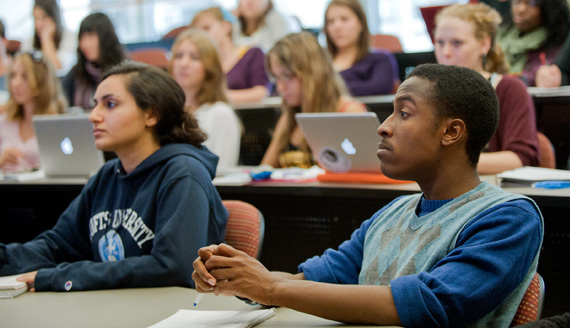
CGS students in a class taught by Professor of Humanities Natalie McKnight. Photo by Kalman Zabarsky
If you talk to alums from any era (you can check out a list of notable CGS alums on the College’s website), those similarities are reflected in their memories.
“I think they will say they made their best friends here—even way back when,” says Wells. “The team structure gives them a sense of belonging. Most alums remember CGS in a way that they don’t necessarily remember their junior and senior years.”
Central to that is the Capstone Project. A 50-page group paper culminating in an oral defense, Capstone is often considered the defining CGS experience. Teams of sophomores are given a contemporary real-world problem—Should the U.S. join the International Criminal Court? In a future of genetic sequencing, who owns our genes?—and given four weeks to come up with a solution, either in the form of a policy recommendation or an arbitrator’s ruling.
Mark DiCristofaro (CGS’06, COM’08), now a film producer in California, completed his Capstone Project on eminent domain. “Will I ever need that knowledge? Maybe. But what I do use on a daily basis is the ability to think critically, problem solve, and communicate as a team member. Those are distinctions, in my experience, that have enabled me and other CGS alumni to take on projects of all types with the confidence and the desire to make a difference in our fields of choice.”
What Does the Future Hold?

Recent renovations at CGS have improved community and study spaces. Photos by Kalman Zabarsky
What's next for CGS? Will it celebrate a 75-year anniversary? And, if it does, where will it be and what will it be called? Given recent renovations to the lobby, classrooms, and study centers at its present location, 871 Commonwealth Avenue, it will probably stay put. But the name?
“We have wanted to change the name,” reveals Wells. “We just can’t set upon what.” The College of Integrated Liberal Studies? Too vague, perhaps. The College of Interdisciplinary Studies? Pronounced with a hard c, not the best acronym. But Wells does think a name change “might be helpful” in the College’s quest to “have more national visibility.”
The first step in that push was the 2011 opening of the Center for Interdisciplinary Teaching & Learning. Wells likens it to a research center at a hospital—a place to study and promote improved approaches to its primary mission. “The center will allow us to do a better job of teaching first- and second-year students,” she says, “and a better job of communicating nationally and internationally the value of a liberal arts general education.”
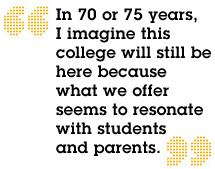
It’s a value Wells believes is universal. In fact, forget the 75th anniversary; she’s confident CGS will celebrate its 130th birthday party in fine health.
“In 70 or 75 years, I imagine this college will still be here because what we offer seems to resonate with students and parents,” she says. “Classically educated students who know how to analyze, research, problem solve, speak and write well, and work both independently and on a team—sounds like a winning formula for a great job or career.”
This article is based on stories originally published in the summer 2012 edition of the College of General Studies magazine, Collegian. Patrick L. Kennedy contributed to this article.
60 Years of the CGS Evolution
Center Brings Student Services Together
The Center for Student Services unites support and resource programs—and serves up fancy mac and cheese.
By Jessica Ullian
Photos by Kalman Zabarsky and Cydney Scott
Warning: students at BU may be suffering from culture shock this fall. When they left campus last spring or after a summer orientation, 100 Bay State Road was a construction site near Kenmore Square. When classes started in September 2012, however, the brand-new Center for Student Services was open for business, redefining the east entrance to Boston University and radically transforming dining, academic support, and career planning offerings on campus.
The six-story building includes three dining locations and a central lounge, nicknamed The Ellipse, where students can congregate. It’s also the new home of the Center for Career Development, the Educational Resource Center, and several College of Arts & Sciences advising and academic support programs. These offices, previously scattered across campus, are taking advantage of their new location to revamp their student outreach and make 100 Bay State Road a destination for students across the University.
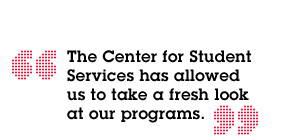
“The Center for Student Services has allowed us to take a fresh look at our programs, as well as present a fresh physical face,” says Laurie Pohl, vice president of enrollment and student affairs. “We wanted to be sure we were putting modern, state-of-the-art services into this modern, state-of-the-art building.”
By concentrating the programs in a new location, Pohl says, students seeking anything from a chemistry tutor to a résumé critique will find a one-stop shop for support. “The idea is to take a more holistic view of these services and functions to help students succeed,” she says. “We want them to come in with an appointment, and leave with a plan.”
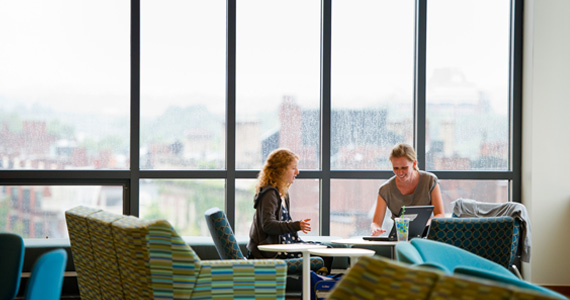
A Good Start
Many members of the Class of 2016 have already visited, beginning their yearlong freshman composition requirement with seminars at the Writing Program, which offers introductory classes to first-years at eight of BU’s undergraduate schools, or taking FY101, the intro-to-college seminar offered by Student Programs & Leadership. The move has provided both programs with major physical upgrades—enhanced classrooms, private tutorial space, activity group meeting areas—but the new comforts are just part of the appeal. With advising and academic support services gathered under one roof, there’s unprecedented opportunity for undergraduates to take advantage of all the resources available. Students dropping by for a writing class can get a firsthand look at peer mentorship or student government in action. Others coming to meet with an academic advisor can walk down the hall for help with a term paper.
“We’re really hoping to become a destination for students,” says Joseph Bizup, director of the Writing Program. “And we’re having a lot of conversations about how to leverage our services to deliver something that’s coherent, integrated, and good.”
Sustained Success
The focus goes far beyond freshmen, too: the Center for Career Development (CCD) and the Educational Resource Center (ERC) are putting their heads together to engage students at every stage of college life, and help them forge a path to the future. “Our strategic plan includes both centers, building on the idea that students mature academically, which leads to a maturation of their professional goals,” says Glenn Wrigley, director of the ERC, which provides services such as foreign language conversation groups and academic skills workshops.
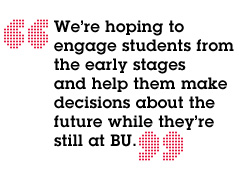
The two centers are launching a joint student ambassador program, recruiting students to assist with community building and outreach, and training them to help with cover letters and provide résumé critiques, so they can deliver more student consultations, even at peak times of year. “We’re hoping to engage students from the early stages and help them make decisions about the future while they’re still at BU,” says Kimberly G. DelGizzo, CCD director.
Both centers share a high-profile promotional space on the first floor, intended to alert students to their main locations upstairs. The new offices also offer ample room for both centers’ needs: a tutorial room can become an interview room as needed, while study areas, with flat-screen monitors for laptops, are also used by campus recruiters leading information sessions for job-seeking students.
Fuel for Thought
If career planning and peer tutoring don’t get students in the door, Director of Dining Services Barbara Laverdiere has a secret weapon: prosciutto macaroni and cheese with an Asiago-sage crust.
The new dining options at 100 Bay State Road start with a bakery and café called Rize. There’s also Late Night Kitchen, where students can have what Laverdiere calls “comfort food with a twist,” like stuffed burgers or that mac and cheese. It’s a sit-down restaurant setup, but students can use their meal plan to purchase dinner.
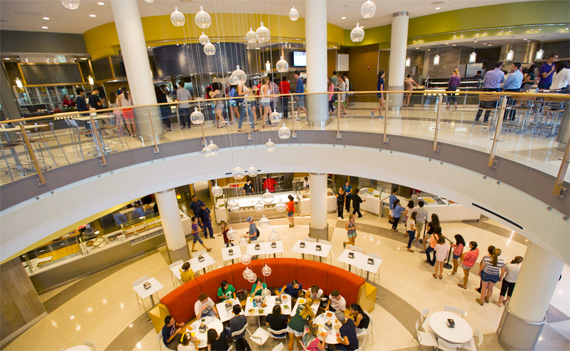
Finally, there’s the two-story dining room, called the Fresh Food Company at Marciano Commons. A cross-campus sibling to the Fresh Food Company at West Campus, this dining hall seats 920 (and serves around 5,000 meals every day) and replaces the older dining halls at three nearby residences. The space has 12 dining stations for every meal, healthy menu options from BU Sargent Choice Nutrition Center, digital menu boards with nutrition information, and two kitchens dedicated to vegan and gluten-free meals to prevent cross-contamination.
“The new building has really given us a chance to do everything we’ve ever wanted,” says Laverdiere, who notes that the new kitchens feature energy-efficient appliances and advanced recycling and composting systems. “When students saw the space, they were blown away.”


